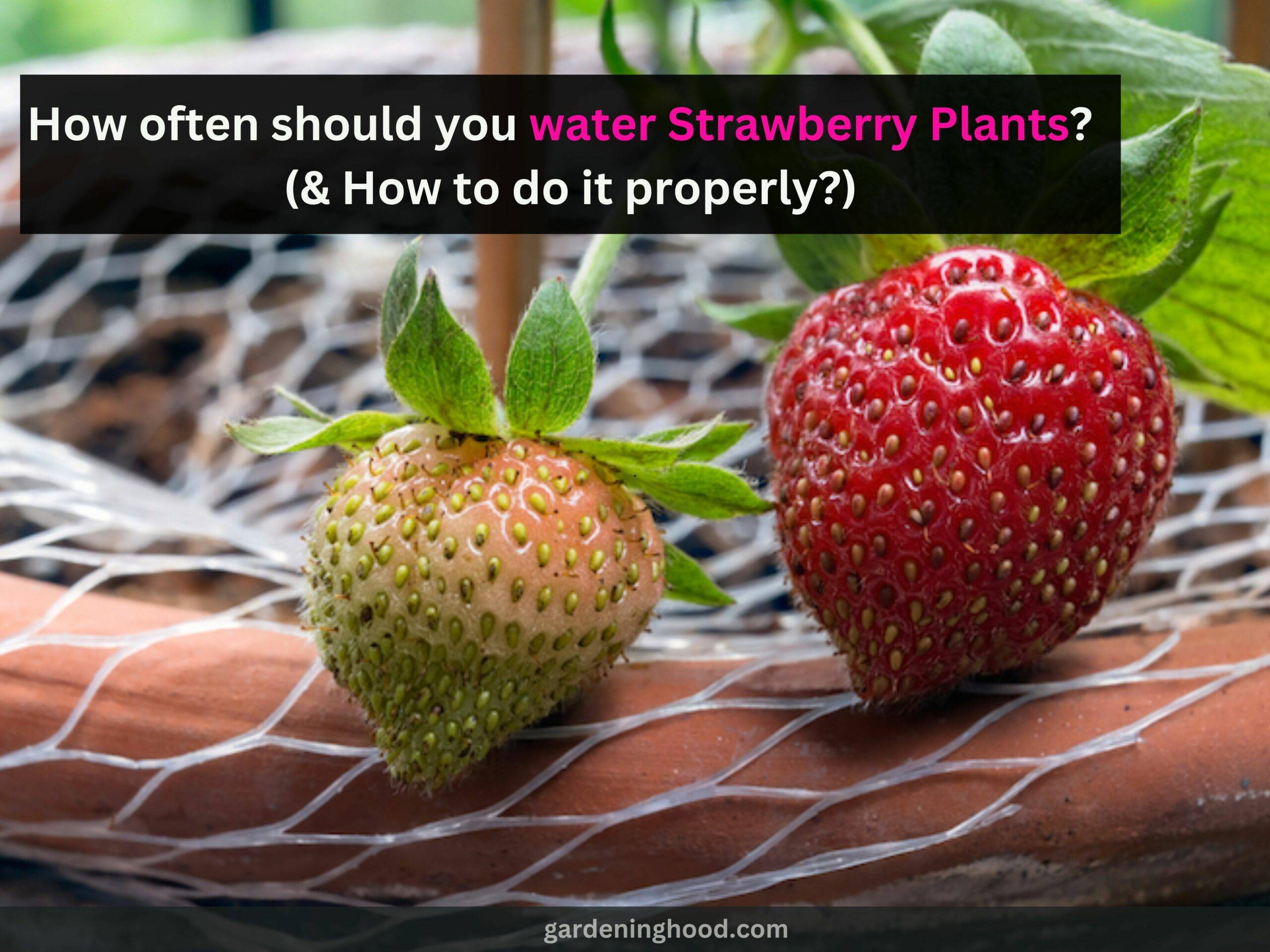What is Seascape Strawberry? – Growing and Caring for Seascape Strawberry
Hey folks! Welcome back!
Do you know What is a Seascape Strawberry? The high-yielding, easy-care Seascape strawberry (Fragaria ananassa ‘Seascape’) stands out from other day-neutral or perennial strawberries because of its conical, deep red fruit that bears from summer to fall.
Strawberry lovers who want to harvest delicious, sweet berries more than once will opt for perennial or day-neutral varieties. Seascape, released by the University of California in 1992, is a great choice for day-neutral strawberries.
Quick takeaways:
- Strawberries are like rich, fertile, well-drained soil.
- If the soil is too sandy, adding mulch will help retain moisture during dry summer months.
- Plants also don’t like wet soil, so avoid growing in clay.
- If you pick the plants well, don’t leave old or moldy fruits on the plants for too long, they will produce more fruit.
Let’s know everything about these Seascape Strawberry plants, along with a few growing and caring tips as you come to know about the growing and caring of the sweet broom shrubs.
| Hardiness Zone | Zones 4-9 |
| Exposure | Full Sun |
| Harvest | Late Spring – Fall |
| Soil | Ideal pH 6.5 – 6.8, sandy loam |
| Water | Moderate water, keep soil evenly moist |
| Maintenance | Fertilize and mulch |
| Plant Type | Day-neutral |
| Berry Flavor | Sweet and tart |
| Berry Size | Large |
What is a Seascape Strawberry?
Do you know about the strawberry seascape? Kuddos, Strawberry Seascape is a spring-grown herb root, an immortal strawberry that produces one crop in spring and another in fall.
Seascape produces high-quality, very sweet berries that are round and uniform in shape. Sea-view fruits are large and have an attractive luster. They bear great fruit in the spring and are one of the most reliable producers in the fall.
Seascape was introduced in 1992 by the University of California Breeding Program. This day-neutral strain is very successful in summer and fall production in the Northeast.
These plants have the potential to be the most productive day neutrals. The berries are large and firm and have a good flavor when picked from the plant when ripe.
According to most Seascape berries, these strawberries are heat and disease-resistant and yield high yields. Because of their modest fibrous roots, they can be grown in containers and also in the field.
They’re hardy in USDA zones 4–8, and one of the best strawberry varieties that you easily grow in containers like Tillamook Strawberry, Mignonette, Fresca, and Tristar for producers in the northeastern United States.
Features of Strawberry Seascape
The strawberry seascape is one of the varieties that are planted at the time of spring that will produce its foliage in the springtime and another at the time of fall. Below are the features of strawberry seascape:
- This variety is large and has an amazing glossy finish.
- It will be produced in the time of spring.
- It is considered a reliable source of fruit at the time of fall.
- They are of high quality.
- They are round-shaped and are equal from all angles.
- You will see that they will grow the fruit well in dry conditions also.
More strawberry facts:
- Strawberries are considered as one of the perennials.
- You have to provide a sunny location for your strawberries as full sunlight will be harmful to them.
- You have to keep the seeds of the berries apart 8 to 12 inches from each other.
- You can grow them in large containers or 3 to 5-gallon pots.
How do you grow Seascape Strawberries?
So, Let’s learn how to grow these seascape strawberries easily with the help of the following steps. Do you know Seascape strawberries ripen 12 inches tall with a spread of 12 to 24 inches? Yes, it is true.
Step 1- Space plants 24 inches apart and 36 to 48 inches apart to allow room to walk between plants without damaging the canopy.
Step 2- Make sure the crown of the plant, which is the base of the stem, is slightly above the surrounding soil to prevent crown rot.
Step 3- Water well after planting, then spread a 2- to 3-inch straw mulch around the plant to keep the roots cool.
Step 4- 1 to 2 inches of water should be applied once a week or however when the ground feels dry beneath the surface.
This is how you are done with the planting of your seascape strawberries in your yard to make them beautiful.
How do seascape strawberries taste?
The taste of the strawberries is amazing as when you take one bite, you will become addicted to it as the taste of these varieties is amazing. They are not only delicious, but they will also provide great sweetness and tartness to your dishes.
The berries of this plant are firm. They are not too big as they are medium. so you can make use of such berries in the desert as they will taste amazing because they will increase the flavor of the desert. It will provide you with the fresh flavor of the berries.
Where to Grow the Strawberry Seascape?
Growing strawberry seascape is not a difficult task. All you need to know is the best location for the variety so that you receive healthy results from it.
You can grow them at the time of summer or fall. It will serve you as a long-lasting evergreen at the time of hot climatic conditions.
Growing Conditions of Strawberry Seascape
What about the growing conditions of this variety? below are the points that will give you the clarification of it. They are as follows:
- It will grow best in the full sunlight.
- At the time of hot climatic conditions, you can provide them with afternoon shade.
- Provide this variety with a good amount of well-drained and rich soil.
- At the arrival of winter, they will not be able to tolerate the frost.
- You have to provide a good amount of space between the plants to increase the flow of air.
- You have to provide them with water for about 1 inch or 3 cm every week.
- At the time of summer, that is when the weather is too hot, water them more.
- They will grow well in the heat and like to grow in the temperature ranges up to 90°F.
- They are considered as one of the winter-hardy plants because they grow well in Cold climatic conditions.
How to take care of Seascape Strawberries?
Do you think these strawberries need much care? No, it is not true as with other strawberries, seascape strawberry requires very little care.
- They prefer rich, fertile soil that drains well in full sun. Full sun is required for maximum berry production. This is where container planting can come in handy; you can move the container to an area with the best sunlight.
- Plant seascape strawberries in intricate rows, densely planted, or in containers. Bare-root strawberries should be planted in the garden about 8 to 12 inches apart.
For more such plant-related articles, you may also read, What is Tillamook Strawberry?- How to plant and take care of Tillamook Strawberries?
- If you choose to grow Seascape in a container, choose a container with drainage holes and a capacity of at least 3-5 gallons (11-19 liters).
- When growing seascape strawberries, make sure to give them an inch of water per week depending on weather conditions.
- If you are growing berries in containers, they may need more frequent watering.
- Keeping the strawberries properly picked promotes the vines to fruit, consequently keeping them well-chosen for a large harvest of strawberries all season.
Wrapping up the context
In this article, you come to know all about the Seascape Strawberry Plants. Strawberries are like rich, fertile, well-drained soil. If the soil is too sandy, adding mulch will help retain moisture during dry summer months.
Plants also don’t like wet soil, so avoid growing in clay. If you pick the plants well, don’t leave old or moldy fruits on the plants for too long, they will produce more fruit. I hope this article will be helpful for you all.
Thanks for reading! Happy Gardening!


